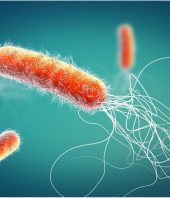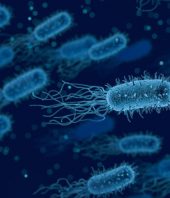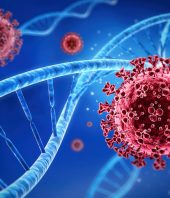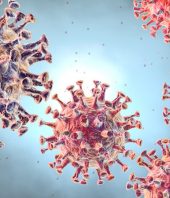A cataclysm may have jump-started life on Earth. A new scenario suggests that some 4.47 billion years ago—a mere 60 million years after Earth took shape and 40 million years after the moon formed—a moon-size object sideswiped Earth and exploded into an orbiting cloud of molten iron and other debris.
The metallic hailstorm that ensued likely lasted years, if not centuries, ripping oxygen atoms from water molecules and leaving hydrogen behind. The oxygens were then free to link with iron, creating vast rust-colored deposits of iron oxide across our planet's surface. The hydrogen formed a dense atmosphere that likely lasted 200 million years as it ever so slowly dissipated into space.
After things cooled down, simple organic molecules began to form under the blanket of hydrogen. Those molecules, some scientists think, eventually linked up to form RNA, a molecular player long credited as essential for life's dawn. In short, the stage for life's emergence was set almost as soon as our planet was born.
That scenario captivated participants at an October 2018 conference here, where geologists, planetary scientists, chemists, and biologists compared notes on the latest thinking on how life got its start. No rocks or other direct evidence remain from the supposed cataclysm. Its starring role is inferred because it would solve a bevy of mysteries, says Steven Benner, an origin of life researcher at the Foundation for Applied Molecular Evolution in Alachua, Florida, who organized the Origins of Life Workshop.
The metal-laden rain accounts for the distribution of metals across our planet's surface today. The hydrogen atmosphere would have favored the emergence of the simple organic molecules that later formed more complex molecules such as RNA. And the planetary crash pushes back the likely birthdate for RNA, and possibly life's emergence, by hundreds of millions of years, which better aligns with recent geological evidence suggesting an early emergence of life.
The impact scenario joins new findings from laboratory experiments suggesting how the chemicals spawned on early Earth might have taken key steps along the road to life—steps that had long baffled researchers. Many in the field see a consistent narrative describing how and when life was born starting to take shape. "Fifteen years ago, we only had a few hazy ideas" about how life may have come about, says Andrej Lupták, a chemist at the University of California (UC), Irvine, who attended the meeting. "Now, we're seeing more and more pieces come together."
The case isn't settled, Lupták and others say. Researchers still disagree, for example, over which chemical path most likely gave rise to RNA and how that RNA combined with proteins and fats to form the earliest cells. Nevertheless, Benner says, "The field is in a new place. There is no question."
The RNA world
Life as we know it likely emerged from an "RNA world," many researchers agree. In modern cells, DNA, RNA, and proteins play vital roles. DNA stores heritable information, RNA ferries it inside cells, and proteins serve as chemical workhorses. The production of each of those biomolecules requires the other two. Yet, the idea that all three complex molecules arose simultaneously seems implausible.
Since the 1960s, a leading school of thought has held that RNA arose first, with DNA and proteins evolving later. That's because RNA can both serve as a genetic code and catalyze chemical reactions. In modern cells, RNA strands still work alongside proteins at the heart of many crucial cellular machines.
In recent years, chemists have sketched out reactions that could have produced essential building blocks for RNA and other compounds. In 2011, for example, Benner and his colleagues showed how boron-containing minerals could have catalyzed reactions of chemicals such as formaldehyde and glycolaldehyde, which were probably present on early Earth, to produce the sugar ribose, an essential component of RNA. Other researchers have laid out how ribose may have reacted with other compounds to give rise to individual RNA letters, or nucleosides.
But critics such as Robert Shapiro, a biochemist at New York University in New York City who died in 2011, often pointed out that when researchers produced one pre-RNA chemical component or another, they did so under controlled conditions, adding purified reagents in just the right sequence. How all those steps could have occurred in the chaotic environment of early Earth is unclear at best. "The analogy that comes to mind is that of a golfer, who having played a golf ball through an 18-hole course, then assumed that the ball could also play itself around the course in his absence," Shapiro wrote in 2007 in Scientific American. He favored a "metabolism first" view of life's origin, in which energetic small molecules trapped inside lipidlike membranes or other compartments established chemical cycles resembling metabolism, which transformed into more complex networks. Other researchers, meanwhile, have argued that simple proteins were a more likely driver of early life because their amino acid building blocks are far simpler than the nucleotides in RNA.
Arguments have sometimes been heated. At a 2008 meeting on the origin of life in Ventura, California, Shapiro and John Sutherland, a chemist at the University of Cambridge in the United Kingdom, wound up shouting at each other. "Bob was very critical about published routes to prebiotic molecules," Sutherland says. If the chemistry wasn't ironclad, "he felt it failed."
I think we’re seeing back to how life began billions of years ago.
Today, Benner says, "The amount of yelling has gone down." A steady stream of new data has bolstered scenarios for how RNA could have arisen. For example, although Benner and his colleagues had previously shown how ribose may have formed, they could not explain how some of its ingredients—namely, the highly reactive small molecules formaldehyde, glycolaldehyde, and glyceraldehyde—could have survived. Geochemists have long thought that reactions sparked by lightning and ultraviolet (UV) light could have produced such compounds. However, Benner says, "There's no way to build up a reservoir" of those compounds. They can react with one another, devolving into a tarlike glop.
Benner now has a possible solution, which builds on recent work suggesting early Earth had a wet-dry cycle. On the basis of evidence from tiny, almost indestructable mineral crystals called zircons, researchers think a modest amount of dry land was occasionally doused with rain. In a not-yet-published study, he and colleagues in the United States and Japan have found that sulfur dioxide, which would have belched from volcanoes on early Earth, reacts with formaldehyde to produce a compound called hydroxymethanesulfonate (HMS). During dry times, HMS would have accumulated on land "by the metric ton," Benner says. The reverse reaction would have happened more slowly, regenerating formaldehyde. Then, when rains came, it could have washed in a steady trickle into puddles and lakes, where it could react to form other small organic molecules essential for building RNA. Similar processes, Benner says, could have provided a steady supply of glycolaldehyde and glyceraldehyde as well.
The sugar ribose is only one piece of RNA. The molecule also strings together four ring-shaped bases, which comprise the letters of the genetic code: cytosine (C), uracil (U), adenine (A), and guanine (G). Making them requires a supply of electron-rich nitrogen compounds, and identifying a plausible source for those has long challenged origin of life researchers. But other recent advances in prebiotic chemistry, which assume a supply of those compounds, have identified a set of reactions that could have produced all four of RNA's genetic letters at the same time and place. In 2009, for example, Sutherland and his colleagues reported a plausible prebiotic reaction for making C and U, chemically related letters known as pyrimidines. Then, in 2016, a team led by chemist Thomas Carell from Ludwig Maximilian University in Munich, Germany, reported coming up with a plausible way to make A and G, known as purines. The trouble was that Sutherland's and Carell's routes to pyrimidines and purines required different reaction conditions, making it difficult to imagine how they could have taken place side by side.
At the workshop, Carell reported a possible solution. He and his colleagues found that simple compounds likely present on early Earth could react in several steps to produce pyrimidines. Nickel and other common metals trigger the last step in the sequence by swiping electrons from intermediate compounds, causing them to react with one another. It turns out that gaining electrons enables the metals to then carry out a final step in synthesizing purines. What's more, those steps can produce all four nucleosides in one pot, thereby offering the first plausible explanation for how all four RNA letters could have arisen together.
Benner calls Carell's solution very clever. But not everyone is on board. Sutherland notes that those reactions are inefficient; any nucleosides they produced might fall apart faster than they could accumulate. To address that concern, others argue that more stable RNA-like compounds, rather than RNA itself, might have emerged first and helped form the first chemical system that could reproduce itself. Later, those RNA mimics might have given way to more efficient modern biomolecules such as RNA.

Some of Earth’s oldest mineral fragments, called zircons, were recently extracted from rock in Australia’s Jack Hills. They harbor chemical inclusions that suggest early Earth was cool enough to have liquid water.
NASA/MCT/MCT VIA GETTY IMAGES
Whichever route RNA's letters took, other researchers have recently worked out how minerals likely present on early Earth could have added phosphate groups to RNA nucleosides, an essential step toward linking them into long strings of RNA that could then have acted as catalysts and a rudimentary genetic code. And many experiments have confirmed that once RNA chains begin to grow, they can swap RNA letters and even whole sections with other strands, building complexity, variation, and new chemical functions. At the meeting, for example, Niles Lehman, a chemist at Portland State University in Oregon, described experiments in which pairs of 16-letter-long RNA chains, known as 16-mers, rearranged to form 28-mers and 4-mers. "This is how we can go from short things that can be made prebiotically to more complex molecules," Lehman said. Later, he quipped, "If you give me 8-mers, I'll give you life."
That process may help explain how more complex RNA molecules arose, including those that can propel the synthesis of simple proteins. At the meeting in Atlanta, chemist Ada Yonath presented one such prototypical proteinmaking RNA. Yonath, of the Weizmann Institute of Science in Rehovot, Israel, shared the 2009 Nobel Prize in Chemistry for working out the atomic structure of the ribosome, the complex molecular machine inside today's cells that translates the genetic code into proteins. Yonath's original structure was of a bacterium's ribosome. Since then, she and her colleagues, along with other groups, have mapped the ribosomes of many other species. Modern ribosomes are behemoths, made up of dozens of protein and RNA components. But at their core, all ribosomes have a sinuous string of RNA with a narrow slit through which budding proteins emerge. The structure is virtually identical across species, unchanged after billions of years of evolution.
Her group has now synthesized that ribosomal core, which she refers to as the protoribosome. At the meeting, she reported that her team's protoribosome can stitch together pairs of amino acids, the building blocks of proteins. "I think we're seeing back to how life began billions of years ago," Yonath says.
All that is still a long way from demonstrating the emergence of life in a test tube. Nevertheless, Clemens Richert, a chemist at the Institute of Organic Chemistry at the University of Stuttgart in Germany, says the recent progress has been heartening. "We're finding reactions that work," he says. "But there are still gaps to get from the elements to functional biomolecules."
Earth’s mysteries
One major gap is identifying a source for the energetic nitrogen-containing molecules needed to make the RNA bases. Lightning and UV light acting on compounds in the atmosphere may have made enough of them, says Jack Szostak, an origin of life expert at Harvard University. At the meeting, Stephen Mojzsis, a geologist at the University of Colorado in Boulder, argued that the moon-size impact is a more plausible spark.
Mojzsis didn't set out to grapple with the origin of life. Rather, he and his colleagues were looking for ways to make sense of a decades-old geological conundrum: the surprising abundance of platinum and related metals in Earth's crust. In the standard picture of Earth's formation, they simply shouldn't be there. The violent assembly of the planet from smaller bodies 4.53 billion years ago would have left it as a boiling sea of magma for millions of years. Dense elements, such as iron, gold, platinum, and palladium, should have sunk to the planet's core, whereas silicon and other light elements floated nearer the surface. Yet as the wares in any jewelry store testify, those metals remain plentiful near the planet's surface. "Precious metals in the crust are thousands of times more abundant than they should be," Mojzsis says.
The long-standing explanation has been that after Earth cooled enough to form a crust, additional metals arrived in a hail of meteors. On the basis of ages of moon rocks brought back by Apollo astronauts, geologists suspected this assault was particularly intense from 3.8 billion to 4.1 billion years ago, a period they refer to as the Late Heavy Bombardment (LHB).
But that scenario has problems, Benner says. For starters, fossil evidence of complex microbial mats called stromatolites shows up in rocks just a few hundred million years younger than the hypothetical bombardment. That's a narrow window in which to move from zero organic molecules to full-blown cellular life.
Zircons—those tiny, durable crystals—also pose a challenge, says Elizabeth Bell, a geologist at UC Los Angeles. Zircons are hardy enough to have remained intact even as the rocks that originally housed them melted while cycling into and out of the planet's interior.
In 2015, Bell and her colleagues reported in the Proceedings of the National Academy of Sciencesthat zircons dated to 4.1 billion years ago contain flecks of graphitic carbon with a lifelike combination of carbon isotopes—biased toward carbon's lighter isotope over its heavier one. Bell concedes that an as-yet-unknown nonbiological process might account for that isotope mix, but she says it suggests life was already widespread 4.1 billion years ago, before the end of the LHB. Other recent zircon data, including samples from as long ago as 4.32 billion years, hint that very early Earth had both liquid water and dry land, suggesting it was more hospitable to life than originally thought. "We're pushing back further and further the time when life could have been formed on Earth," Bell says.
Collision course
Mojzsis argues that a moon-size cataclysm 4.47 billion years ago could explain both Earth's veneer of precious metals and an early start for life. In December 2017, he and two colleagues published a set of extensive computer simulations in Earth and Planetary Science Letters showing how the current distribution of metals could have originated in the rain of debris from such an impact. Simone Marchi, a planetary scientist at the Southwest Research Institute in Boulder, and colleagues reached much the same conclusion in a paper the same month in Nature Geoscience. Marchi's team, however, simulated not one moon-size impactor, but several smaller bodies, each about 1000 kilometers across.
Whether one impact or a few, those collisions would have melted Earth's silicate crust, an event that appears to be recorded in data on isotopes of uranium and lead, according to Mojzsis. The collisions also would have profoundly affected Earth's early atmosphere. Before the impact, the cooling magma and rocks on the surface would have spurted out gases, such as carbon dioxide, nitrogen, and sulfur dioxide. None of those gases is reactive enough to produce the organic compounds needed to make RNA. But Benner notes the blanket of hydrogen generated by the impact's metallic hail would have formed exactly the kind of chemically reducing atmosphere needed to produce the early organics. Robert Hazen, a geologist at the Carnegie Institution's Geophysical Laboratory in Washington, D.C., agrees that hydrogen could help. With that reducing atmosphere, the wide array of minerals on the planet's surface could have acted as catalysts to propel the chemical reactions needed to make simple organics, Hazen says.
Just before the impact, Mojzsis says, "there was no persistent niche for the origin of life." But after the impact and a brief period of cooling, he adds, "at 4.4 billion years ago, there are settled niches for the propagation of life."
"I'm delighted," Benner says. "Steve [Mojzsis] is giving us everything we need" to seed the world with prebiotic chemicals. And by eliminating the need for the LHB, the impact scenario implies organic molecules, and possibly RNA and life, could have originated several hundred million years earlier than thought. That would allow plenty of time for complex cellular life to evolve by the time it shows up in the fossil record at 3.43 billion years ago.
Enduring enigmas
Not everybody accepts that tidy picture. Even if geologists' new view of early Earth is correct, the RNA world hypothesis remains flawed, says Loren Williams, a physical chemist at the Georgia Institute of Technology here and an RNA world critic who attended the workshop. "I like talking to Steve Benner," Williams says. "But I don't agree with him."
One major problem with the RNA world, he says, is that it requires a disappearing act. An RNA molecule capable of faithfully copying other RNAs must have arisen early, yet it has vanished. "There's no evidence for such a thing in modern biology," Williams says, whereas other vestiges of ancient RNA machines abound. The ribosome's RNA core, for example, is virtually unchanged in every life form on the planet. "When biology makes something, it gets taken and used over and over," Williams notes. Instead of an RNA molecule that can copy its brethren, he says, it's more likely that early RNAs and protein fragments called peptides coevolved, helping each other multiply more efficiently.
Advocates of the RNA world hypothesis concede they can't explain how early RNA might have copied itself. "An important ingredient is still missing," Carell says. Researchers around the globe have designed RNA-based RNA copiers in the lab. But those are long, complex molecules, made from 90 or more RNA bases. And the copiers tend to copy some RNA letters better than others.
Still, enough steps of an RNA-first scenario have come into focus to convince advocates that others will follow. "We are running a thought experiment," says Matthew Powner, a chemist at University College London. "All we can do is decide what we think is the simplest trajectory."
That thought experiment was on full display in the workshop's final session. Ramon Brasser of the Tokyo Institute of Technology, one of Mojzsis's collaborators, stood at the front of a small conference room and drew a timeline of Earth's earliest days. A red slash at 4.53 billion years ago on the left side of Brasser's flip chart marked Earth's initial accretion. Another slash at 4.51 billion years ago indicated the moon's formation. A line at 4.47 billion years ago marked the hypothetical impact of the planetesimal that gave rise to an atmosphere favorable to organic molecules.
Benner asked Brasser how long Earth's surface would have taken to cool below 100°C after the impact, allowing liquid water to host the first organic chemical reactions. Probably 50 million years, Brasser said. Excited, Benner rushed up to the timeline and pointed to a spot at 4.35 billion years ago, adding a cushion of extra time. "That's it, then!" Benner exclaimed. "Now we know exactly when RNA emerged. It's there—give or take a few million years."
Source: Science Magazine, Full Article






